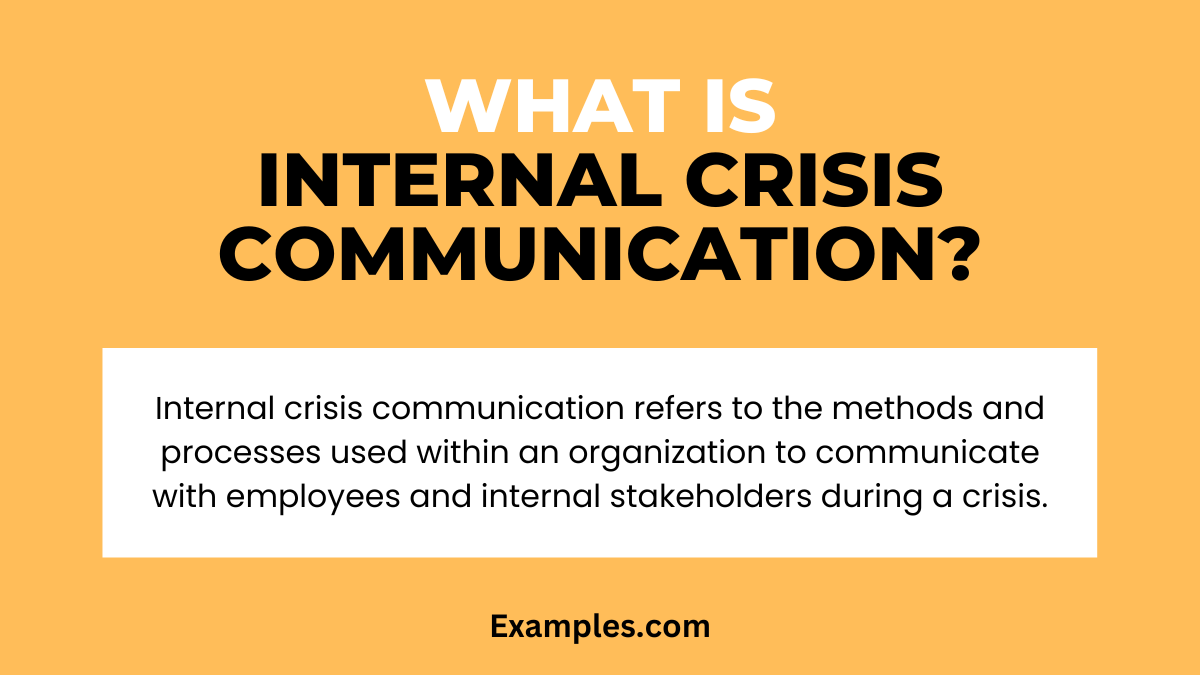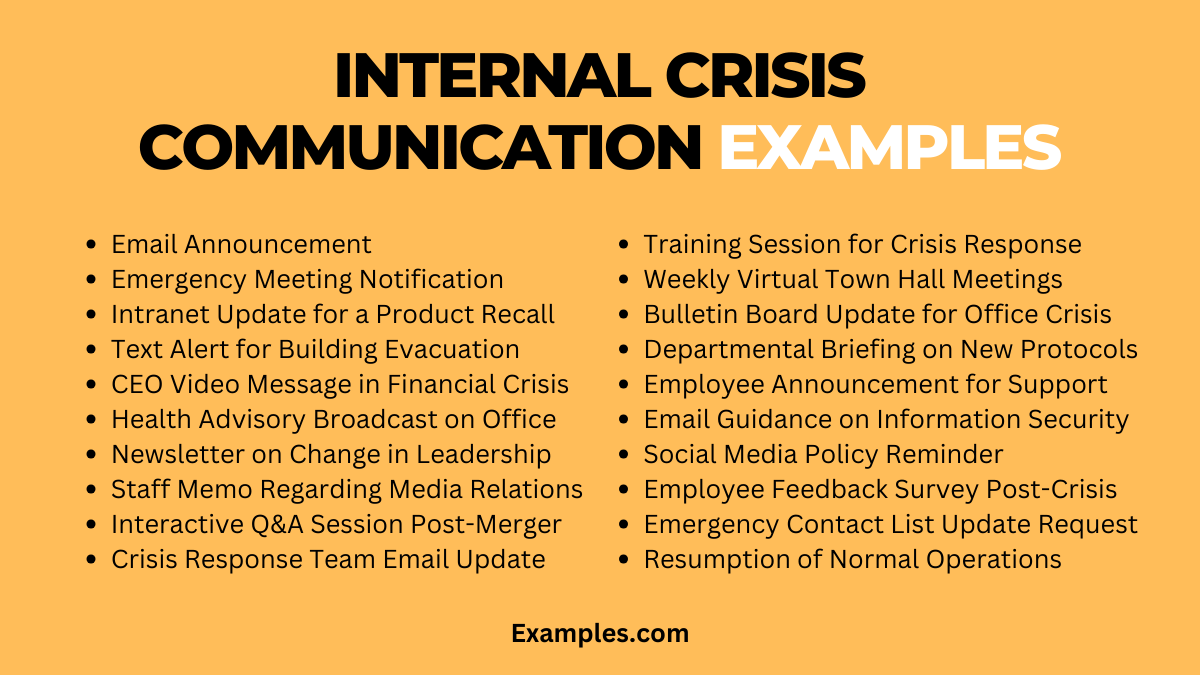19+ Internal Crisis Communication Examples
Internal Crisis Communication is a critical component of organizational resilience and management. This guide delves into effective strategies for maintaining clear communication within an organization during crises. It includes practical examples and insights on how to disseminate information, manage employee concerns, and uphold operational integrity under challenging circumstances. By prioritizing transparent and timely communication, businesses can navigate crises more effectively, ensuring a cohesive and informed internal environment.
What is Internal Crisis Communication?

Internal crisis communication refers to the methods and processes used within an organization to communicate with employees and internal stakeholders during a crisis. This involves sharing information, updates, and instructions with staff to ensure they are informed, prepared, and know how to respond. Effective internal communication is crucial for maintaining morale, ensuring safety, and fostering a sense of unity and support among employees during challenging times.
20 Internal Crisis Communication Examples

Effective internal crisis communication is pivotal for organizations to manage emergencies. This guide presents 20 distinct examples, showcasing how businesses can effectively relay critical information to employees during a crisis. Each example includes practical sentences and strategies to ensure clear, concise, and transparent communication, maintaining employee trust and operational continuity.
- Email Announcement of a Cybersecurity Breach: “We have detected a security breach impacting our systems. We are actively investigating and will provide updates as we work to resolve this issue.”
- Emergency Meeting Notification for Natural Disaster Response: “An emergency team meeting is scheduled for 10 AM to discuss our response to the recent earthquake. Attendance is crucial.”
- Intranet Update During a Product Recall: “Please be advised of the immediate recall of Product X due to safety concerns. Details for customer communication and product return processes are on the intranet.”
- Text Alert for Immediate Building Evacuation: “Emergency evacuation required due to gas leak. Please exit the building via the nearest safe route and meet at the designated assembly point.”
- CEO Video Message During Financial Crisis: “Our company is facing financial challenges. In this video, I discuss our strategy moving forward and answer some of your concerns.”
- Health Advisory Broadcast on Office Intranet During Pandemic: “Important health advisory: New COVID-19 guidelines are in effect. Please review them on our intranet and adhere strictly for your safety.”
- Newsletter on Change in Leadership During Organizational Crisis: “Announcing leadership changes during our restructuring phase. We are committed to a smooth transition and continuous excellence.”
- Staff Memo Regarding Media Relations Post-Scandal: “Reminder: All media inquiries related to the recent scandal should be directed to our PR team. Do not engage directly.”
- Interactive Q&A Session Post-Merger Announcement: “Join our live Q&A session to address your concerns and queries about the recent company merger.”
- Crisis Response Team Email Update During Litigation: “Our legal team is handling current litigation. Please refrain from external comments and direct all inquiries to legal.”
- Online Training Session for Crisis Response: “Mandatory online training on crisis management is now available. Please complete it by the end of this week.”
- Weekly Virtual Town Hall Meetings During Prolonged Crisis: “Join our weekly virtual town halls to stay updated on ongoing crisis management efforts and company health.”
- Bulletin Board Update for Localized Office Crisis: “Notice: Due to the water damage in Building B, operations will temporarily move to Building C.”
- Departmental Briefing on New Safety Protocols: “Department heads will brief their teams on the new safety protocols effective immediately.”
- Employee Hotline Announcement for Personal Crisis Support: “Our employee support hotline is now active for anyone needing assistance or counseling during this difficult time.”
- Email Guidance on Information Security During Remote Work: “While working remotely, please follow these enhanced information security guidelines to protect company data.”
- Social Media Policy Reminder During Public Relations Crisis: “Reminder: Our social media policy prohibits discussing company matters publicly, especially during the current PR crisis.”
- Employee Feedback Survey Post-Crisis Evaluation: “Your feedback on our crisis management is valuable. Please complete the post-crisis survey.”
- Emergency Contact List Update Request: “Please ensure your emergency contact information is updated in our system for any urgent communications.”
- Announcement of Resumption of Normal Operations Post-Crisis: “We are pleased to announce the resumption of normal operations following the resolution of the crisis. Thank you for your cooperation.”
Why is Internal Crisis Communication Important?
Effective internal communication plays a pivotal role in managing a crisis within an organization. Here’s an expanded look at the key aspects:
- Maintaining Staff Morale: During crises, employees often experience uncertainty and anxiety. Through transparent and timely communication, organizations can address these concerns, providing reassurance and stability.
- Ensuring Consistent Messaging: Consistency in messaging is crucial. Employees should receive the same information and updates, ensuring a unified understanding of the crisis and the organization’s response.
- Empowering Employees: Well-informed employees are invaluable assets. When they understand the situation and the organization’s actions, they can effectively communicate with external stakeholders, such as customers, partners, and the public.
- Facilitating Operational Continuity: Clear communication is vital for ensuring that all departments and teams can function effectively, even in challenging times. By providing guidance, updates, and support, internal communication helps maintain operational continuity, preventing disruptions that could exacerbate the crisis.
- Building Trust: Transparency in internal communication is essential for building and maintaining trust within the organization. When employees perceive that their leaders are open and honest about the crisis and its impact, trust is reinforced.
What are the Internal Crisis Communication Strategies?
Effective internal crisis communication is essential for managing a crisis within an organization. Here’s an expanded explanation of each point:
- Regular Briefings: Keeping employees informed through regular updates is crucial. These briefings should include the latest information about the crisis, the company’s response, and any changes in protocols or procedures.
- Clear, Concise Messaging: During a crisis, it’s important to communicate in a way that everyone can understand. Avoid technical jargon or complex language that may confuse employees. Clear and concise messaging ensures that everyone is on the same page and can follow instructions effectively.
- Two-Way Communication Channels: Establishing two-way communication channels, such as dedicated email addresses or forums, allows employees to ask questions and provide feedback.
- Training and Preparedness: To prepare for potential crises, organizations should conduct training and simulations. This helps employees understand their roles and responsibilities in crisis situations.
- Leadership Visibility: During a crisis, employees look to their leaders for guidance and reassurance. Leaders should be visible and actively communicate with employees. This includes addressing concerns, providing updates, and demonstrating a strong commitment to resolving the crisis.
- Tailored Messages for Different Departments: Recognize that different departments may have unique roles and responsibilities during a crisis. Tailor your communication to be relevant to each department’s specific needs and functions.
How to Manage a Crisis Using Internal Communication?
Effective crisis communication within an organization is essential for managing and mitigating potential crises. Here’s an expansion of the provided points:
- Clear Leadership Communication: Clear and decisive communication from leadership sets the tone during a crisis. Leaders should articulate the situation, the organization’s response, and expectations clearly. This provides employees with a sense of direction and confidence in leadership.
- Frequent Updates: Keeping employees informed through regular updates is crucial. These updates should include the latest developments, actions taken, and any changes in the situation. Frequent communication helps reduce uncertainty and anxiety among staff.
- Two-Way Communication Channels: Establishing two-way communication channels, such as feedback mechanisms and open forums, allows employees to express their concerns, ask questions, and provide valuable insights. This fosters a sense of involvement and ensures that leadership is responsive to employee needs and queries.
- Crisis Communication Training: Providing employees with crisis communication training equips them with the skills to handle communication during challenging times. Training should cover the basics of crisis communication, including message consistency, empathetic communication, and using appropriate channels.
- Consistent Message Across Departments: It’s essential that all departments within the organization convey consistent messages. Inconsistencies in communication can lead to confusion and undermine the organization’s credibility. Coordinating messaging ensures that everyone is on the same page.
Tips for Conducting Effective Internal Crisis Communication
Creating an effective communication plan is crucial in crisis management. It involves several key components:
- Establish a Communication Plan: Before a crisis occurs, organizations should have a well-defined communication plan in place. This plan outlines the strategies and channels that will be used to disseminate information internally.
- Prioritize Transparency: Transparency is essential during a crisis. Employees should be informed about the situation as soon as possible. Being honest about the severity of the crisis and its potential impact is critical for trust-building.
- Empathetic Messaging: During a crisis, employees may be anxious or concerned. It’s important to convey empathy and understanding in all communications. Acknowledge their feelings and concerns while providing information and reassurance.
- Role Clarity: Clearly define the roles and responsibilities of individuals involved in crisis communication. This includes identifying who will be the primary spokesperson, who will coordinate messaging, and who will handle various aspects of communication.
- Post-Crisis Feedback: After the crisis has been managed, gather feedback from employees. This feedback can provide insights into the effectiveness of communication strategies and areas that may need improvement. Use this information to refine future crisis communication plans.
By following these principles and incorporating them into a well-structured communication plan, organizations can navigate crises more effectively and maintain trust among their employees.
In conclusion, effective internal crisis communication is essential for preserving trust and maintaining employee morale during challenging times. Open and transparent communication, coupled with timely updates and a supportive environment, plays a crucial role in navigating crises within an organization. By prioritizing clear and empathetic messaging, companies can successfully weather internal crises and emerge stronger as a cohesive team.



